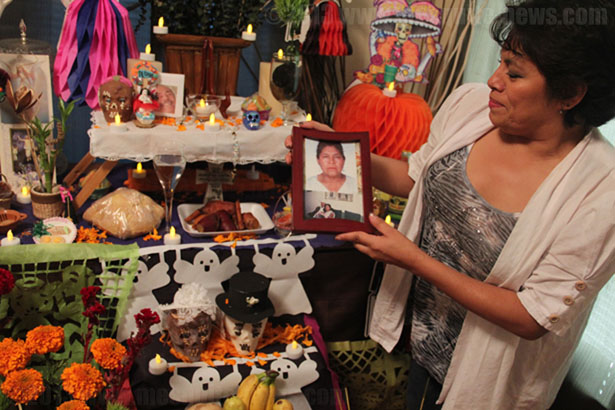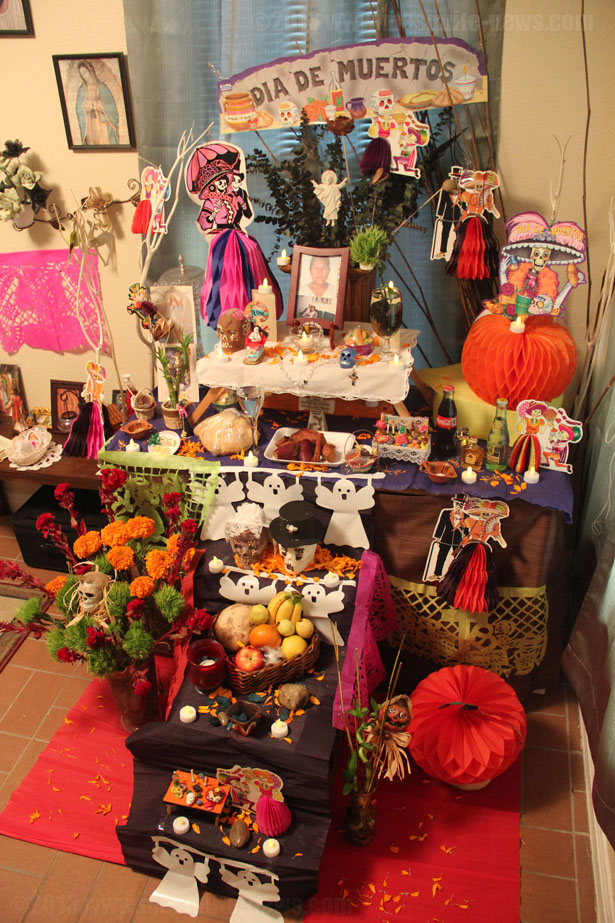
By Lucia Espino
Despues de más de 13 años viviendo en este país, nunca había visto tanto interés en las celebraciones del Día de los Muertos como hasta hace algunos años atrás.
Nacida en México, las tradiciones de mi cultura van de mi mano a cada momento y los festejos del Día de los Muertos son de los importantes y especiales que tengo con migo.
Es importante saber que esta celebración dura más que un solo día. El 1° de noviembre es Día de Todos los Santos y se recuerda a los niños que han fallecido. El 2° de noviembre es el Día de los Muertos y es el día que recordamos a los adultos.
Muchos piensan que esta fecha es solo para creyentes de la religión Católica y que significa pintarse la cara de calavera y visitar el panteón.
Pero en realidad, es una tradición Mexicana donde la gente espera a que sus familiares que se adelantaron en el camino nos visiten, al mismo tiempo que muestran respeto a la que no hace distinción ante nadie, la muerte.
En el 2003, la Organización de las Naciones Unidas para la Educación, la Ciencia y la Cultura o UNESCO, declaró esta costumbre Mexicana como Patrimonio Oral e Inmaterial de la Humanidad.
En este país, normalmente, organizaciones religiosas o aquellas que representan a la comunidad Hispana, son las que se encargan de crear altares para el Día de los Muertos en lugares públicos para que todos puedan admirar algo que puede ser considerado una obra de arte.
En realidad, la tradición es que altares como esas sean puestos en hogares y personalizados de acuerdo a cada familia. Pero hay ciertos elementos que un altar del Día de los Muertos debe incluir.
La imagen de La Catrina, mejor conocida como la muerte, esta presente vestida de diferentes formas para ilustrar que la muerte se presenta para llevarnos en cualquier forma o circunstancia.
El papel picado viene de los Aztecas que usaban hojas de árboles con símbolos dibujados en ellas para decorar durante sus rituales. Después de la llegada de los Españoles y el principio de comercio con China, las hojas fueron reemplazadas por lo que ahora es conocido como el papel china, por ser más manejable y colorido.
La flor de cempasúchil (flor de muerto) es cultivada a finales del mes de octubre y es lo que hace que un altar de Día de los Muertos resalte. Por su color anaranjado intenso, se cree que guía el camino de los difuntos hacia cada altar.
La ofrenda ofrece cosas que normalmente son exclusivas de esta temporada, como la calabaza, camote, frutas como la guayaba y mandarina, ademas del famoso pan de muerto. El agua no debe faltar, pues se cree que las almas llegan sedientas después de un largo viaje desde el más allá.
Mi casa no es muy grande. Es por eso que para poner un altar a nuestro gusto usamos la casa de mi Tíia Silvia Espino. Aunque tenemos muchos familiares que ya no estan físicamente con nosotros, nuestro altar es mayormente en honor de mis abuelos paternos Clemencia y Serafin Espino.
Para mi Abuelita Cleme, como la llamamos de cariño, siempre tenemos el agua mineral que tanto tomaba y un rosario que siempre llevaba con ella.
Mi tía recuerda que mi abuelo siempre decia, “A mi me pones muchos dulces”. Por eso no pueden faltar los dulces,además de una Coca-Cola y su tequila.
Símbolos religiosos también son parte de nuestro altar, mi tía dice que, “No es solo para recordar que se fueron, pero para recordar que estan con Dios”.
Las veladoras son para iluminar el camino de las almas hacia el altar. “Siempre prendo una veladora por nuestros familiares y otra por todos los demás que nadie recuerda”, dice mi tía.
Al final del festejo, comemos y tomamos de las ofrendas que pusimos en el altar, para simbolizar una última cena con nuestros seres queridos y decirles que los esperamos el próximo año para seguir celebrando que sus espíritus aún viven entre nosotros – en nuestros corazones.

Translation
Dia de los Muertos, a personal tradition
After more than 13 years living in this country, I have never seen such an interest in Dia de Los Muertos (Day of the Dead) celebrations as I did this year.
Born in Mexico, my traditions and culture are always with me, and Dia de los Muertos celebrations are among the most significant and meaningful ones.
It is important to remember this is not a one-day celebration. Nov. 1, Dia de Todos los Santos (All Saints’ Day), is to remember children who passed away and Nov. 2, Dia de los Muertos (Day of the Dead), is to celebrate the adults who left before us.
Many people believe this celebration is for Catholic church members, the significance lost and summarized as painting our faces like skulls and visiting the cemetery.
In reality, this is a Mexican tradition when we hope those loved ones who passed away will come back and visit us. At the same time, we show our respect to the only one who will not discriminate…death.
This celebration is so important that in 2003, The United Nations Organization for Education, Science and Culture (UNESCO) declared Dia de los Muertos as an Oral and Intangible Heritage of Humanity.
Here in the United States, religious organizations or those who represent the Hispanic community, are usually the ones who have the largest public Dia de los Muertos altars.
In reality, this tradition calls for people to have altars at home and to be personalized according to each family. Public or personal, each altar should have some specific elements.
Images of La Catrina (death) dressed in different outfits and in different situations, illustrate how death will come in any shape or form.
Papel picado (perforated paper) is cut-out patterns on colorful tissue paper. This traditional folk art from Mexico comes from the Aztecs, who drew on leaves and used them as decorations during rituals. Once Mexico began trading with China, leaves were replaced by “papel china” (tissue paper), because it is more manageable and colorful.
La flor de cempasuchil (marigold flower), which mostly grows at the end of October, is used during ceremonies to guide souls to every altar because of it’s bright orange color.
Pan de muerto (bread of the dead) is a type of sweet roll baked only during this celebration must be part of the offering in every altar, along with seasonal fruit and water.
My house does not have much free space, which is the reason reason why we place our altar at the home of my aunt, Silvia Espino. Even though we have several loved ones who are no longer with us, our altar is mostly for my grandmother and grandfather, Clemencia and Serafin Espino.
My grandmother’s rosary and the sparkling water she couldn’t live without, are always part of our altar. For my grandfather, we make sure to have candies, coca-cola and tequila.
“You better put a lot of candies just for me,” my grandfather used to always tell us.
Religious symbols are also part of the altar, my tia said, because “It’s not only to remember that they left, but to remember they are with God.”
Lighted candles are said to guide the way of souls to their altars. “I always lit one for our loved ones, and one for all the ones who might not be remembered,” my aunt said.
At the end of Dia de los Muertos, we eat and drink from the offering. This represents one last meal with those who are no longer with us, and to let them know we will be waiting for them the following year.






